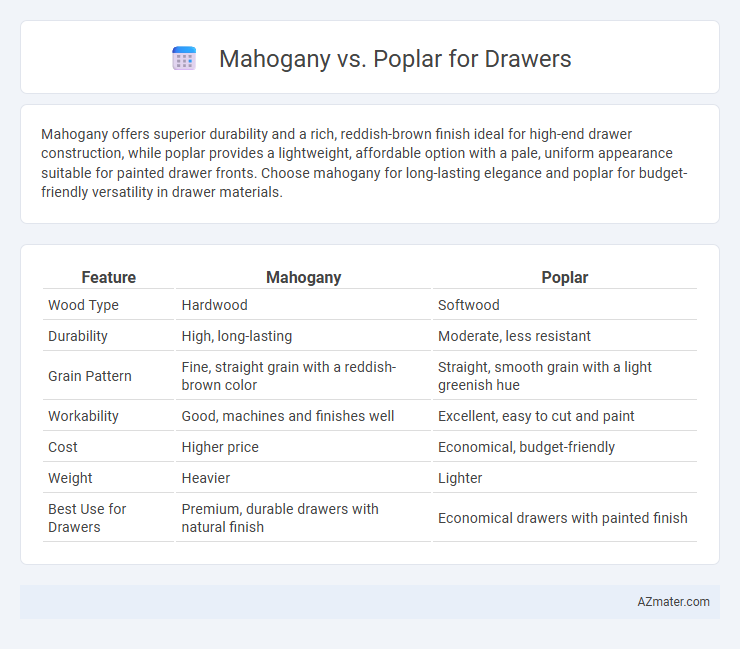Mahogany offers superior durability and a rich, reddish-brown finish ideal for high-end drawer construction, while poplar provides a lightweight, affordable option with a pale, uniform appearance suitable for painted drawer fronts. Choose mahogany for long-lasting elegance and poplar for budget-friendly versatility in drawer materials.
Table of Comparison
| Feature | Mahogany | Poplar |
|---|---|---|
| Wood Type | Hardwood | Softwood |
| Durability | High, long-lasting | Moderate, less resistant |
| Grain Pattern | Fine, straight grain with a reddish-brown color | Straight, smooth grain with a light greenish hue |
| Workability | Good, machines and finishes well | Excellent, easy to cut and paint |
| Cost | Higher price | Economical, budget-friendly |
| Weight | Heavier | Lighter |
| Best Use for Drawers | Premium, durable drawers with natural finish | Economical drawers with painted finish |
Introduction to Mahogany and Poplar Woods
Mahogany is a dense hardwood prized for its rich reddish-brown color, durability, and smooth grain, making it ideal for high-end drawer construction and fine woodworking projects. Poplar is a lightweight, soft hardwood with a pale, uniform color and a relatively straight grain, often used for drawer parts that require ease of machining and cost-effectiveness. Both woods offer distinct structural and aesthetic qualities, with mahogany favored for its strength and luxury appeal, while poplar provides affordability and versatility in drawer manufacturing.
Origins and Botanical Background
Mahogany originates primarily from tropical regions of Central and South America, belonging to the Meliaceae family with species like Swietenia macrophylla known for its rich reddish-brown hue and durability. Poplar, a member of the Salicaceae family, grows mainly in the temperate regions of North America, Europe, and Asia, featuring lighter, softer wood with a pale cream to yellow tone. The botanical differences influence drawer construction, where mahogany offers superior hardness and natural resistance, while poplar provides ease of machining and a cost-effective alternative.
Appearance and Grain Comparison
Mahogany features a rich, reddish-brown color with a smooth, straight grain that deepens over time, offering a luxurious and elegant appearance ideal for high-end drawers. Poplar has a lighter, creamy-white to greenish hue with a more uniform and less pronounced grain, providing a subtle, versatile look that easily accepts paint or stains. The distinct visual warmth of mahogany contrasts with poplar's softer, milder texture, making each wood suited to different aesthetic preferences in drawer construction.
Strength and Durability Differences
Mahogany offers superior strength and durability compared to poplar, making it ideal for drawers that require long-lasting structural integrity. Its dense grain resists warping and dents better than poplar, which is softer and more prone to damage under heavy use. Poplar is suitable for lightweight drawers but lacks the robust hardness that defines mahogany's performance in high-stress applications.
Workability and Ease of Crafting Drawers
Mahogany offers excellent workability with its fine, straight grain, allowing for smooth cuts, sanding, and joining, which makes it ideal for crafting high-quality drawers. Poplar is softer and easier to machine, making it suitable for beginners or faster production, though it may be prone to denting and less durable in drawer construction. Both woods provide good ease of crafting, but mahogany delivers superior finishing and longevity in drawer work.
Weight and Density Considerations
Mahogany typically has a density of about 0.60 to 0.85 g/cm3, making it heavier and denser than poplar, which has a density of approximately 0.40 to 0.50 g/cm3. This higher density gives mahogany greater strength and durability for drawer construction but adds to the overall weight, potentially impacting ease of use. Poplar's lighter weight and moderate density make it easier to handle and suitable for drawers where weight reduction is a priority without sacrificing too much structural integrity.
Cost and Availability
Mahogany is a premium hardwood known for its rich color and durability, but it is significantly more expensive and less readily available compared to poplar. Poplar, a softer and more abundant wood, offers an affordable and accessible option for drawers without compromising basic structural integrity. Choosing between mahogany and poplar depends on budget constraints and the desired finish quality for cabinetry projects.
Environmental Impact and Sustainability
Mahogany, a slow-growing tropical hardwood, often faces criticism for its environmental impact due to deforestation and illegal logging practices, making sustainable sourcing crucial. Poplar, a fast-growing hardwood commonly found in North America, offers a more eco-friendly option owing to its rapid renewability and lower carbon footprint. Choosing FSC-certified poplar or responsibly harvested mahogany helps minimize deforestation while supporting sustainable forest management practices.
Best Uses for Mahogany vs Poplar in Drawers
Mahogany is ideal for high-end drawer construction due to its durability, rich color, and fine grain, making it perfect for luxury furniture and heirloom pieces. Poplar offers a more affordable, lightweight option with good stability, suitable for painted or unfinished drawers in budget-friendly or casual furniture. Both woods perform well, but mahogany excels in premium aesthetics and longevity, while poplar is preferred for versatility and cost efficiency.
Final Verdict: Which Wood is Right for Your Drawers?
Mahogany offers superior durability, rich color, and fine grain, making it ideal for high-end, long-lasting drawer construction. Poplar provides a more affordable, lightweight option with a smooth finish, perfect for painted drawers or budget-conscious projects. Choose mahogany for premium, heirloom-quality pieces and poplar for economical, versatile drawers with easy customization.

Infographic: Mahogany vs Poplar for Drawer
 azmater.com
azmater.com